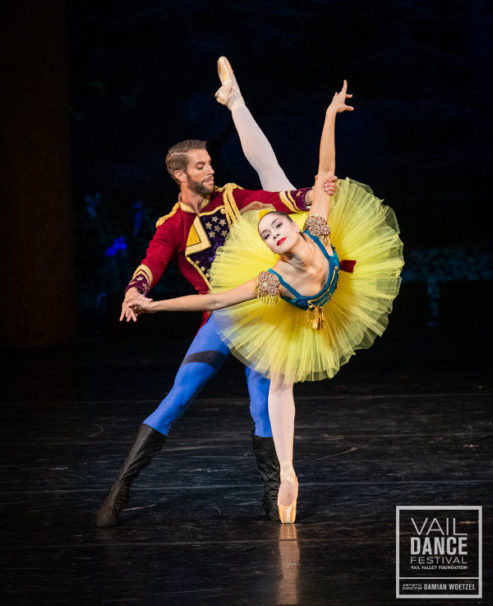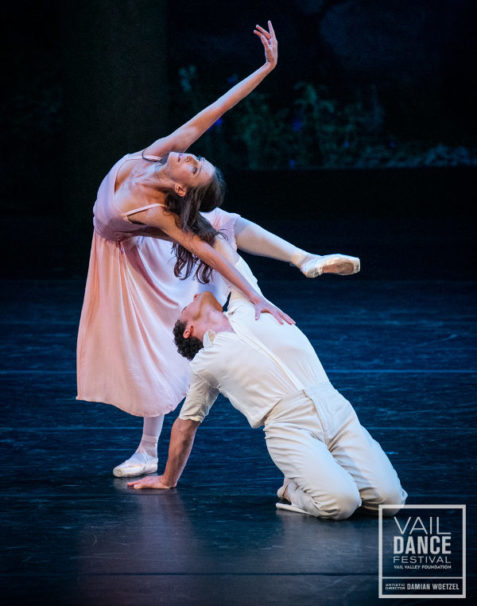
As New York City’s dance venues gear up to re-open next month, in early August a heady mix of the city’s finest dancers brought the thrill of live dance to the Vail Dance Festival. This annual gathering, which assembles an array of luminaries as well as on-the-verge newer talents, had to cancel its 2020 festival, instead producing virtual programs. But this year VDF was back to full strength with a roster of loyal regulars and a few new faces before capacity audiences at the Gerald Ford Amphitheater, an outdoor, yet covered venue.
The three varied programs – two festive International Evenings of Dance and the ambitious NOW: Premieres closing night – showcased dancers who clearly were reinvigorated by the Festival’s distinctive collaborations and unexpected partnerships. Live music, as ever, was a VDF priority and high standards of playing were delivered by Brooklyn Rider, the longtime quartet in residence, along with pianists Cameron Grant and Kurt Crowley and composer in residence Caroline Shaw, who also performed.
The International Evenings offered a smorgasbord: Merce Cunningham juxtaposed with Alonzo King; a generous sampling of Balanchine; and a dollop of Swan Lake and Romeo and Juliet for traditionalists. The first program opened with the kind of collaborative, celebratory work that has become a VDF signature under artistic director Damian Woetzel’s impassioned leadership. Reunion, choreographed by Woetzel, Michelle Dorrance and its seven performers, imaginatively filled the stage with a mix of ballet, jookin’, and tap.

Among the Balanchine offerings, the pas de deux from Stars and Stripes offered the compelling partnership of ABT’s James Whiteside and NYCB up-and-comer Mira Nadon, both making debuts. Whiteside, with his showbiz flair and cheeky charm, was a natural for the role, and Nadon, initially a bit tentative, blossomed into a witty showgirl, radiating confidence.
A cascade of dancers made the second half of Who Cares? a gala-level event. Aside from Tiler Peck, delivering “Fascinatin’ Rhythm” with spectacular verve, most were newcomers to their roles. Isabella Boylston was completely at home in “My One and Only” while Herman Cornejo found the casual and endearing heart of the “Liza” solo. Lauren Lovette and Robbie Fairchild performed “The Man I Love” with heart-stopping beauty. The younger NYCB generation made an impact in other duets: Nadon and Christopher Grant brought stylish sophistication to “Who Cares?” while India Bradley and Phlip Duclos nearly stopped the show in “Embraceable You.”
Bradley, a member of NYCB’s corps de ballet who seems poised for a breakout, was the ultimate VDF performer. She held her own amid the powerhouse Festival talent, seizing her moments not only in the Balanchine but also in Tiler Peck’s Thousandth Orange, an elegantly structured work to a Shaw score. Bradley was at home in both Reunion and Michelle Dorrance’s inspired New to the Session, an ensemble work for which Rhiannon Giddens’ beautiful homespun score turned violin virtuoso Johnny Gandelsman into more of a fiddler, summoning the eight dancers and evoking a heartfelt community.
Vail has had a similar effect on Calvin Royal III, the ABT principal dancer who was especially busy as this year’s Artist-in-Residence. He and NYCB soloist Unity Phelan’s partnership has been nurtured at Vail, and their shared elegance and daring were on view in the Agon pas de deux as well as Christopher Wheeldon’s After the Rain. That very familiar duet took on a strikingly original tone in their performance.
NOW: Premieres (which was live-streamed and can be viewed on YouTube through Monday evening) was an impressive, intensely serious collection of tight new dances, mostly made during the busy ferment of the festival’s two weeks. Each clocked about ten minutes and demonstrated that less is more. Not a moment was wasted, and the cumulative impact was satisfying.
Dorrance’s work was one of three set to solo violin scores that Gandelsman and the Festival commissioned as part of his This is America project. Jamar Roberts took on the thorniest of these new scores, by Tyshawn Sorey. His new work, for the ten members of BalletX joined by Royal, was a sophisticated and challenging. Entitled For Ulysses Dove, its uniform red costumes (filmy red tunics over leotards) were a nod to Dove’s Red Angels. This intriguing ballet, with women on pointe, occasionally evoked Merce Cunningham, with its cool yet intensely focused quiet drama.

VDF regulars Lauren Lovette and Lil Buck set their co-choreographed duet Until We Meet Again to the third of these violin scores, a calm, meditative composition by Courtney Curtin. These two very different dancers, who have cultivated a close friendship at Vail, explored partnering – which Lil Buck took on with ease and flair –pulled together in the center of the stage but left to wander off separately at the end.
Justin Peck’s newest work, Bloom, a traditionally structured pas de deux for Tiler Peck and Herman Cornejo set to a new Caroline Shaw score, included allusions to Tchaikovsky Pas de Deux in its music and in its opening choreography. But in its inventive, fresh and highly challenging choreography for these two virtuosi at the top of their game, Peck emphasized clever musical timings and invigorating footwork and downplayed showy bravura.
Tiler Peck has been choreographing at VDF since 2018, and her third work was haunting. It opened as a trio for Royal, Grant and Roman Mejia who mostly traded off in searching, introspective solos. As they reclined onstage, Mira Nadon entered as an elegiac figure, all long lines and eloquent extensions. Royal partnered her, as their complimentary long lines creating a stunning yet muted impact.

The opening and closing works on the NOW: Premieres evening were less serious and more purely diverting. In A Perpendicular Expression, James Whiteside went to town with six ballet virtuosos and Liszt’s Hungarian Rhapsody (beautifully played by Jacek Mysinski). On first viewing, his ballet seemed playfully bombastic, tossing challenges to his cast (which included himself). These six –Boylston, Fairchild, Phelan and ABT’s Cory Stearns and Devon Teuscher – seemed up to his occasionally absurd challenges despite the long layoff from performance.
Denver-based veteran choreographer Cleo Parker Robinson and her company closed the evening with Standing on the Shoulders, a generic but effective piece that evoked Alvin Ailey-style spirituality and then built to a rousing gospel-meets-jazz finale. Her six company members know how to fill a stage with blazing energy. For good measure they were joined by BalletX, Lil Buck and Ron Myles in final celebratory moments.
Susan Reiter covers dance for TDF Stages and contributes regularly to the Los Angeles Times, Playbill, Dance Australia and other publications.
